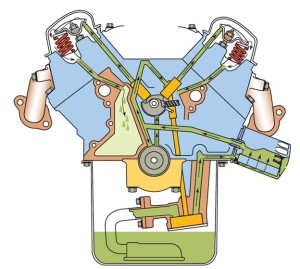Lubrication System
All engines contain moving and sliding parts that must be kept lubricated to reduce wear and friction. The oil pan, bolted to the bottom of the engine block, holds 4 to 7 quarts (4 to 7 liters) of oil.
An oil pump, which is driven by the engine, forces the oil through the oil filter and then into passages in the crankshaft and block. These passages are called oil galleries. The oil is also forced up to the valves and then falls down through openings in the cylinder head and block, then back into the oil pan.
Cooling Systems
All engines must have a cooling system to control engine temperatures. While some older engines were air cooled, all current production passenger vehicle engines are cooled by circulating antifreeze coolant through passages in the block and cylinder head.
The coolant picks up the heat from the engine and after the thermostat opens, the water pump circulates the coolant through the radiator where the excess heat is released to the outside air, cooling the coolant. The coolant is continuously circulated through the cooling system and the temperature is controlled by the thermostat.
The coolant temperature is controlled by the thermostat, which opens and allows coolant to flow to the radiator when the temperature reaches the rating temperature of the thermostat.
Next Steps towards ASE Certification
Now that you’re familiar with Combustion Engine Lubrication & Coolant Systems, try out our free Automotive Service Excellence Tests to see how much you know!
![ASE Certification Training HQ - Free ASE Practice Tests [Updated 2021]](https://asecertificationtraining.com/wp-content/themes/simplefolio/images/ASE Certification Logo.png)


